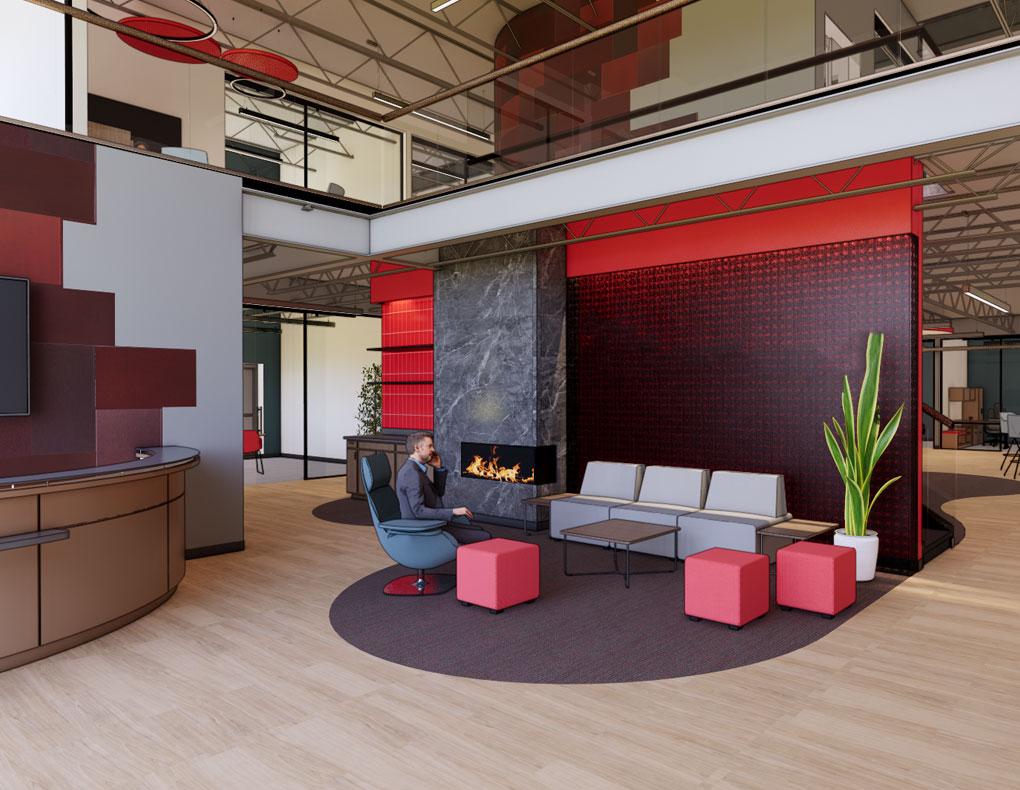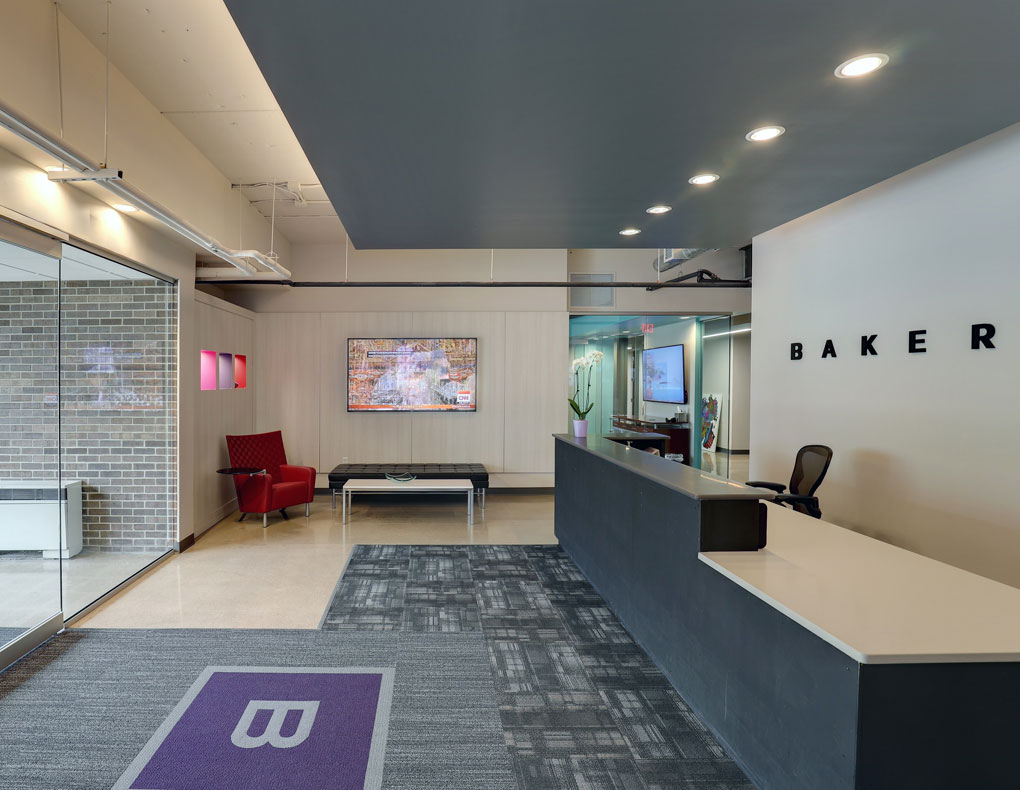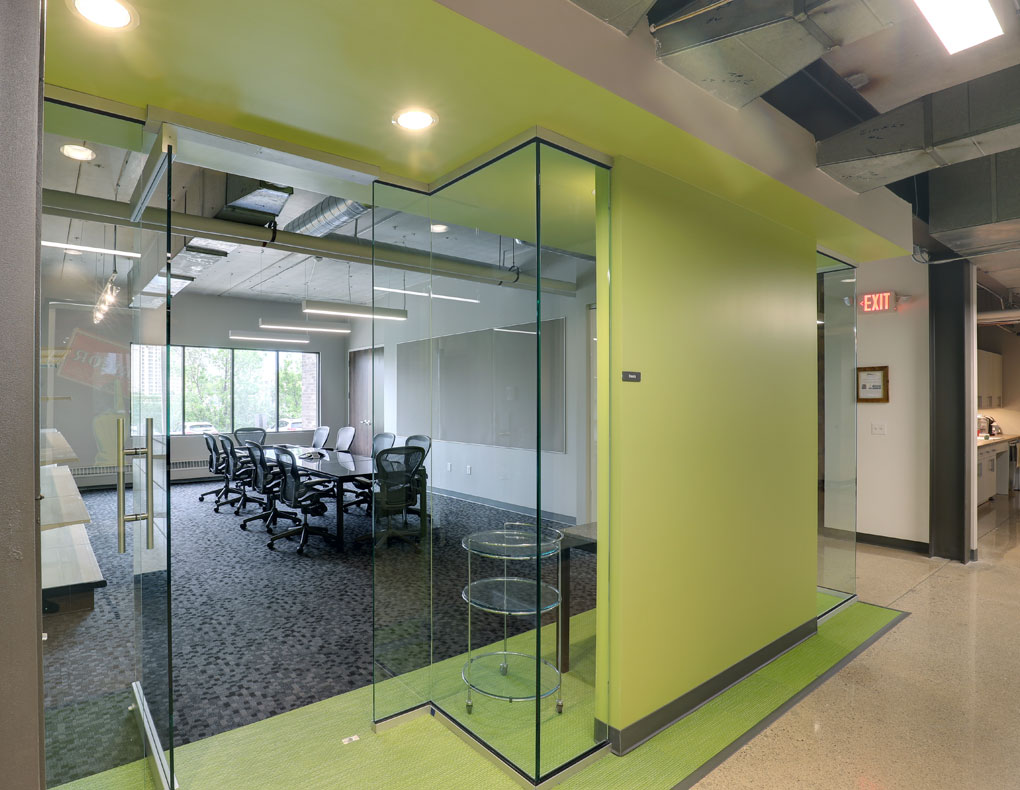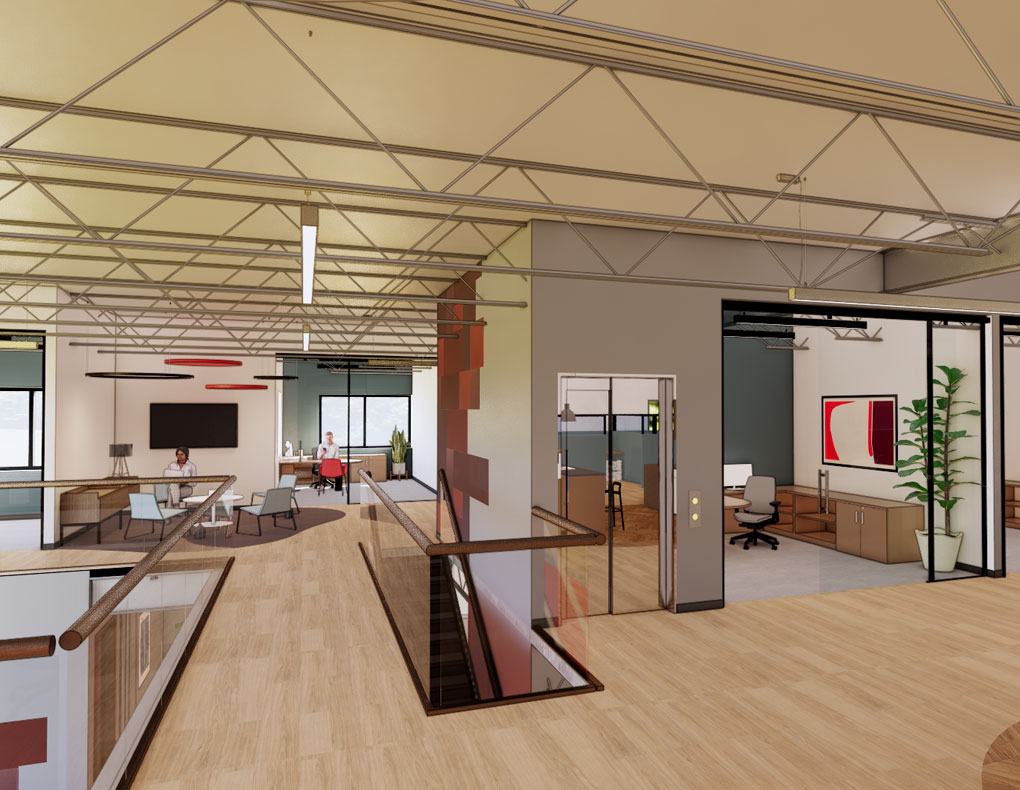Commercial office renovation isn’t really about the space at all.
That may sound confusing – so let me explain what I mean.
I’m calling to mind an old conference room that hadn’t been touched since 2008.
Beige walls, flickering fluorescents, and that one chair that squeaked whenever someone shifted.
Six months after I saw it first, that same space was buzzing with energy.
Natural light now floods collaborative zones, quiet pods offer refuge for deep work, and the coffee bar (yes, an actual coffee bar) has become the unofficial hub for breakthrough ideas.
The space – the size of it at least – remained exactly the same.
But it became a different world – and that can always be true, whether you’re expanding or not.

The Numbers Tell a Story You Can’t Ignore
Organizations are increasingly prioritizing workplace experience as a crucial factor in real estate success. And for good reason.
The vast majority of employees say they’re more productive in hybrid/remote settings, which means your office needs to offer something their home setup can’t.
With energy costs rising and governments tightening emissions regulations, sustainable renovations are delivering measurable ROI.
All of us at Studio M Architects have seen this unfolding.
Working with businesses across the Twin Cities, from downtown St. Paul to Eden Prairie, the pattern reveals itself:
Companies that invest in thoughtful office renovation are revolutionizing how work gets done.
Why Now? The Perfect Storm of Opportunity
Remember when open offices were the answer to everything?
That experiment taught us something valuable: one-size-fits-all doesn’t work.
The pandemic flipped this script, proving that productivity thrives in spaces designed for wellness.
And today’s office renovation responds to how your specific team works best.
Think about it this way. Your office competes with every employee’s home setup.
Their couch. Their perfect coffee. Their dog.
To win that competition, you need to offer something exceptional – genuinely, meaningfully better for certain types of work.
The timing couldn’t be more critical.
In 2024, 91% of workers said they could be persuaded to come into the office if the right benefits were offered.
Space design is one of those benefits.
Research shows 41% of workers mentioned that higher pay would draw them back to the office, but here’s the kicker – office features like more privacy (23%) and additional meeting rooms (14%) were also strong motivators.
The Science Behind Successful Office Transformation

What does modern office renovation actually look like today?
First, forget everything you think you know about cubicles and corner offices.
Today’s workspace is fluid, adaptable, almost organic in how it responds to daily needs.
Task-oriented office design features flexible spaces built to accommodate various activities.
Biophilic Design: More Than Just Plants
One report found biophilic design improved productivity and creativity by as much as 15%.
But this means more than scattering succulents around.
Real biophilic design integrates nature at a fundamental level – living walls that actually purify air, water features that mask distracting noise, natural materials that regulate humidity.
We recently completed a project where the entire east wall became a vertical garden.
The purpose is always creating a natural sound barrier between the workspace and the busy street outside.
Beautiful, yes – but functional first.
The Technology Integration Nobody Talks About
Here’s something we learned working on restaurant designs that translates perfectly to offices: technology should be invisible until you need it.
Furniture equipped with built-in charging ports, wireless connectivity, and integrated technologies ensures that employees remain connected and equipped throughout the day.
This is where environmental controls are really valuable.
According to office design trends research, agentic AI – capable of making autonomous decisions – has accelerated the shift toward hyper-personalised work environments.
Picture walking into a meeting room that remembers your lighting preferences.
Conference tables where screens rise seamlessly when needed, then disappear completely.
These are practical solutions that remove friction from the workday.
Flexibility as a Design Principle
The days of permanent walls and fixed layouts are long gone.
Modular designs that adapt to changing needs … reduce waste from frequent renovations.
Smart, right?
But here’s what makes it brilliant: modular design is profitable.
It’s a common enough scenario: Monday, you need three small meeting rooms. Thursday, you’re hosting a company-wide presentation.
With modular design, the same space transforms effortlessly.
No construction crews or downtime – and a space that works the way you work.
What the Data Really Tells Us About ROI

At the end of the day, renovation is an investment, and investments need returns.
Many commercial spaces enjoy solid ROI after a commercial upgrade, making it easier to sell the business or rent out the space in the future.
The returns go beyond property value, though.
In our experience, these are among the hidden ROI factors that actually matter:
About 69% of employers said their employee retention improved after introducing hybrid policies.
Your renovated office supports those policies by creating spaces worth coming to.
Energy efficiency.
Old HVAC systems, outdated lighting, inefficient windows – they’re often bleeding money.
One Houston project we completed reduced energy costs by approximately 30% through strategic renovation choices.
Productivity gains.
This one’s harder to measure but impossible to ignore.
Studies show those who work from home spend 10 minutes less a day being unproductive and work one more day a week.
Your renovated office needs to match that efficiency.
Brand perception.
Your space affects client confidence in ways you might not expect.
We’ve seen businesses close deals simply because their renovated offices conveyed success and forward-thinking.
The Renovation Roadmap That Actually Works

After twenty years in this business, we’ve refined our approach to something deceptively simple.
Phase 1: Discovery (Not Design)
Before touching a single wall, understand how work actually happens in your space.
How it really happens.
Watch the patterns.
Where do people naturally gather? Which spaces sit empty?
What makeshift solutions have employees created?
That printer everyone moved into the unused conference room?
The unofficial meeting spot by the good coffee machine?
This is all design-related information.
Phase 2: Strategic Planning
This is why our design process is rooted in anticipating tomorrow’s needs while solving today’s problems.
Our key considerations are:
- Traffic flow optimization
- Natural light maximization
- Acoustic management
- Technology infrastructure
- Flexibility for future changes
Phase 3: Phased Implementation
Remember, you don’t need to renovate everything at once.
In fact, you shouldn’t.
Start with high-impact, low-disruption changes.
Maybe that’s transforming an underused storage room into a wellness space.
Or updating lighting throughout the floor.
These quick wins build momentum and let you test concepts before committing to larger changes.
Phase 4: Continuous Evolution
The best office renovations never really end and instead, they evolve.
For this reason, you should think about how to build in flexibility from day one.
Use modular furniture systems. Install infrastructure that can support future technology.
Design spaces that can shift purpose as needs change.
Your office should grow with your business, never constrain it.
The Trends That Matter (And the Ones That Don’t)
Everyone wants to know what’s hot in office design. But trends are tricky.
Chase every trend, and you’ll end up with an expensive mess.
Worth Your Attention:
Hospitality-inspired spaces.
Look at any modern office remodel, and you’ll notice elements borrowed from high-end hotels: curated social zones, aesthetic lounges, and even concierge services.
This creates experiences that make the office destination-worthy.
Wellness integration.
Beyond standing desks and yoga rooms, true wellness design considers air quality, natural light exposure, acoustic comfort, and spaces for mental recharge.
Our restaurant design experience has taught us that comfort directly impacts how long people want to stay in a space.
Neighborhood-based layouts.
Instead of departments scattered across floors, create “neighborhoods” where teams can claim territory while staying connected to the larger organization.
Skip These:
All-glass everything. Looks great in photos, terrible for focus and privacy.
Forced fun zones. That ping-pong table will become a storage surface within weeks.
One-size-fits-all workstations. People work differently. It doesn’t hurt to honor that.
The Sustainability Factor You Can’t Afford to Ignore
In my view, sustainable renovation is an investment with compound returns.
Smart technology for energy management – where lights and temperature adjust automatically based on occupancy.
Simple, effective, and the savings add up fast.
Sustainability goes deeper than energy efficiency, though.
For a space to be truly sustainable, it has to last.
Choose materials that age gracefully, and design systems that can be updated without demolition.
This is the way to build flexibility that prevents the need for frequent overhauls.
We recently worked with a Scottsdale company that wanted desert-inspired design.
Instead of superficial plant decorations, we integrated passive cooling strategies borrowed from traditional southwestern architecture.
The result was dramatic cooling cost reductions and a space that feels authentically connected to its environment.
Making the Decision: Is Renovation Right for You?

Every office needs to evolve.
The question is when and how.
Ask yourself:
- When did you last update your workspace?
- How does your office compare to your competitors’?
- What do employee surveys say about your space?
- Are you losing talent to companies with better environments?
- Does your space support the work styles you’re promoting?
If you’re wincing at any of these questions, it’s time to consider renovation.
The Hidden Benefits
Beyond the obvious improvements, commercial office renovation delivers unexpected advantages.
Renovation becomes a rallying point, a tangible sign of investment in the team’s future.
We’ve helped companies who’ve used renovation as an opportunity to redefine their culture, involving employees in design decisions and creating spaces that embody their values.
It can even be a form of recruitment management because your space tells your story before you say a word.
Potential employees are comparing your office to every other opportunity, and space speaks volumes about how you value your people.
And of course, new spaces inspire new thinking.
Environmental changes trigger cognitive flexibility, making renovation a catalyst for business innovation.
The Bottom Line That Really Matters
Commercial office renovation is about creating spaces where great work happens naturally.
If your space pulls the best from its people, by nourishing them and making them come alive, business dynamics start falling into place.
Whether you’re in Phoenix dealing with desert heat or Galveston managing coastal challenges, the principles remain consistent: thoughtful design, strategic planning, and a clear vision for how space can transform work.
The truth is, we spend too much of our lives at work for those spaces to feel like afterthoughts.
And honestly…?
Once you experience what a truly well-designed workspace can do for your company culture, for your daily energy, for that elusive thing we call employee engagement, you’ll wonder why you waited so long.
Ready to transform your commercial office into a space that actually works?
At Studio M Architects, we’ve spent over 20 years helping businesses across the country create spaces that inspire productivity, attract talent, and drive growth.
Contact us today for a free consultation and discover how the right renovation strategy can revolutionize your entire business.
Let’s create something extraordinary together because your team deserves a space as ambitious as they are.

Recent Comments